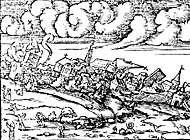Quake research unearths promising results

A Zurich seismologist has developed a method of estimating how many weak earthquakes are not picked up by seismic measuring stations.
This information could help with risk assessment and quake prediction, according to Jochen Wössner from the Swiss Seismological Service at the Federal Institute of Technology in Zurich.
Despite technical progress made in recent years, measuring earthquakes is still not perfect. Whether seismometers record an earthquake depends on the one hand on the density and quality of the monitoring network, and on the other on the strength and location of the actual quake.
The new method, published in the Bulletin of the Seismological Society of America by Wössner and Danijel Schorlemmer at the University of Southern California, can calculate the smallest magnitude of earthquake a particular network can pick up.
“We first define a probability of detecting an earthquake of a specific magnitude and a specific distance from the seismic station,” Wössner told swissinfo on Tuesday.
“We then use a combination of probabilities from all of the stations to calculate the overall probability of detecting an event at a specific point with the entire network. Traditional methods have been based on quakes registered in earthquake catalogues – but the catalogues aren’t complete.”
Practical benefits
Methods of estimating the number of weak earthquakes are important because they enable scientists to predict with greater accuracy the frequency of strong, destructive quakes.
“We can really extrapolate our knowledge,” Wössner said.
He added that the new method could also be used as a tool for planning networks. Using a computer model to work out how many monitoring stations are needed is more cost effective than going out into the field, building a station and doing a longer-term research project.
“Finally we can use it as an information tool for ongoing earthquake forecasts and experiments. You need complete detection of earthquakes in a specific region to build a very good model for making forecasts,” he said.
Swiss shakes
Wössner and Schorlemmer tested the method in Southern California. They concluded that the density of seismometers there was insufficient to register with 100 per cent certainty quakes of a magnitude of less than 3.3. Humans can feel such quakes if they are in the vicinity of the epicentre.
The results of the tests in Switzerland have yet to be analysed, but Wössner believes that because of the country’s high density of monitoring stations – a seismometer can be found every 10-20 kilometres – the detection threshold will be as low if not lower than in Southern California.
In canton Valais quakes can be detected down to a magnitude of 1.4, he said.
“The seismicity in Switzerland is low compared with regions such as Southern California or Japan. However, there is a constant earthquake risk in Switzerland. For example there was a 6.6 magnitude event in the 14th century in Basel,” he said.
In Switzerland 300-400 earthquakes are recorded annually. Basel is one of Switzerland’s highest risk zones for earthquakes, although the most recent tremor to cause any noticeable damage struck canton Graubünden in 1991.
“We need to know how the small events behave in Switzerland and how we can extrapolate from those,” Wössner said.
swissinfo, Thomas Stephens
An earthquake is the result of a sudden release of energy in the Earth’s crust that creates seismic waves.
Earthquakes are recorded with a seismometer, also known as a seismograph, which prints out seismograms.
Magnitude 3 or lower earthquakes are mostly imperceptible and magnitude 7 cause serious damage over large areas.
At the Earth’s surface, earthquakes manifest themselves by shaking and sometimes displacing the ground. When a large earthquake epicentre is located offshore, the seabed sometimes suffers sufficient displacement to cause a tsunami.

In compliance with the JTI standards
More: SWI swissinfo.ch certified by the Journalism Trust Initiative












You can find an overview of ongoing debates with our journalists here . Please join us!
If you want to start a conversation about a topic raised in this article or want to report factual errors, email us at english@swissinfo.ch.